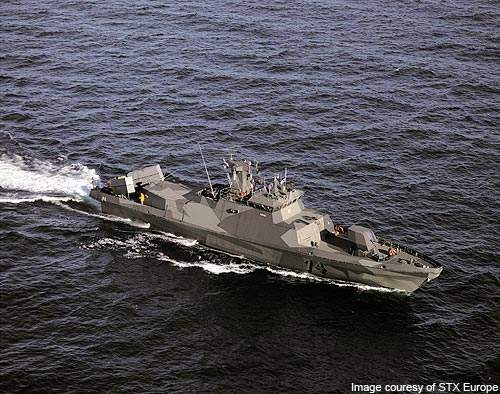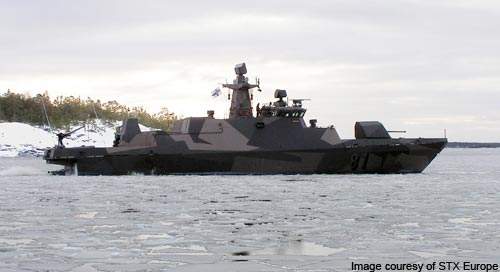The Hamina Class fast attack craft were built by Aker Finnyards in Rauma, Finland for the Finnish Navy. Previously known as Rauma 2000, fast attack craft regularly patrol the Finnish coastline. Four vessels home-ported at Upinniemi are operated under Squadron 2000.
The Hamina Class fast attack craft is capable of conducting patrolling and combat missions as a missile boat. The lead vessel in class, FNS Hamina was ordered in December 1996 and commissioned in August 1998. The order for the second craft, FNS Tornio, was placed in February 2001. It was commissioned in May 2003. The third, FNS Hanko was ordered in December 2003 and commissioned in June 2005. The final ship in the class, FNS Pori, was ordered in February 2005 and commissioned in June 2006.
The Hamina has an overall length of 51m, a waterline length of 44.3m, a breadth of 8.3m and a design draft of 1.7m. Displacement of the ship is 250t and the vessel’s full complement is 23.
Hamina Class design and features
Designed specifically as a stealth ship, the Hamina Class features a round bilge aluminium mono-hull, with a superstructure made of reinforced carbon fibre composite. The shape and materials used reduce the ship’s magnetic, heat and radar signatures. Radar absorbent materials such as kevlar and balsa cover the ship’s metal structures, while its composite parts are made from radar absorbent material.
The low displacement of the Hamina enhances its manoeuvrability. These ships are equipped with water jets instead of propellers, so they operate easily in shallow waters and unconventional waterways. The Hamina Class vessels feature many surveillance and combat capabilities usually found on much larger ships.
The Hamina has the facility to exhaust gases under water, thus reducing thermal signature, or into the air which minimises sound pick-up by submarines. There are 50 nozzles fitted around the decks and upper structures that can spray seawater to cool the vessel, and clean it in case of chemical attack or radioactive fall-out. The life saving equipment includes four inflatable life rafts and one inflatable rescue boat.
Command and control system
The Hamina Class fast attack craft is equipped with TACTICOS (tactical information and command system) combat data system developed by Thales Nederland (formerly Signaal). The centralised combat management system is based on commercial-off-the-shelf (COTS) designs. The system integrates all sub-systems for improving the capability of the craft to simultaneously engage and defeat various types of threats.
Anti-ship missiles
The latest weapon systems are integrated with the state-of-the-art command system. The vessel is armed with four RBS-15 mk3 anti-ship missiles each with a range of over 100km. The onboard Umkhonto-IR surface-to-air missile system can simultaneously engage up to eight aircraft within a 14km range. There is a Bofors 57mm gun installed for surface and aerial targets and two 12.7mm heavy machine guns are also fitted on the craft. The ship can also be fitted with mine rail to detect sea mines.
Sensors and radar equipment
The ship is equipped with TRS-3D multimode acquisition radar, Raytheon ARPA navigation radar and Signal Scout I-band surface search radar. The sonar suite includes a Simrad Subsea Toadfish active high-frequency search and attack sonar, and a Sonac/PTA towed array sonar.
Hamina Class countermeasures
The Rheinmetall MASS (multi-ammunition soft-kill system) can protect the craft from sensor-guided missiles by launching Philax chaff and infrared flare decoys. The vessel is also equipped with an Etienne Lacroix anti-threat optronic screening (ATOS) system. Electronic support measures (ESM) are provided by a MEL Matilda radar intercept.
Rolls-Royce waterjet propulsion
Hamina Class vessels are propelled by Rolls-Royce Kamewa 90SII waterjets powered by two MTU 16V538 TB93 diesel engines. Each engine, rated at 2,760kw, provides a maximum speed of 30kt and a range of 500nm. Auxiliary power is generated by two 270KVA +1 diesel gensets.





